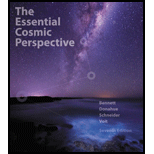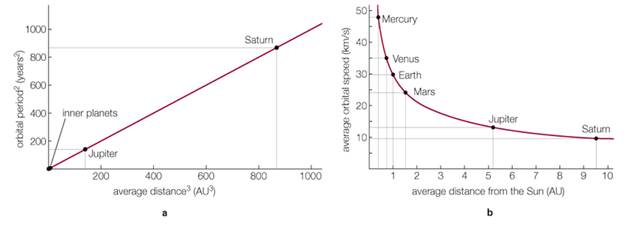
The Essential Cosmic Perspective (7th Edition) - Standalone book
7th Edition
ISBN: 9780321928085
Author: Jeffrey O Bennett, Megan O. Donahue, Nicholas Schneider, Mark Voit
Publisher: PEARSON
expand_more
expand_more
format_list_bulleted
Textbook Question
Chapter 3, Problem 7VSC
Use the information in the graphs to answer the following questions.
Check your understanding of some of the many types of visual information used in astronomy. For additional practice, try the Chapter 3  Visual Quiz at Mastering Astronomy.
Visual Quiz at Mastering Astronomy.

7. How far does the planet in question 6 orbit from the Sun?
a. 10 AU
b. 100 AU
c. 1000 AU
d.
Expert Solution & Answer
Want to see the full answer?
Check out a sample textbook solution
Students have asked these similar questions
What is the answer
between a planet and its moon.
Procedure/Analysis:
Go to: https://www.physicsclassroom.com/Physics-Interactives/Circular-and-Satellite-
Motion/Gravitational-Fields/Gravitational-Fields-Interactive
Use the program to answer the following questions.
1. A planet and its moon are shown in the simulation window. Click and drag the
moon to various positions about the planet and observe the gravitational force
vector. In the diagram below, draw a force vector (arrow with arrowhead) to
depict the direction and relative magnitude of the force acting upon the moon at
the designated locations. Note: the size of the arrow should be representative of
the strength of the force.
Please answer parts C and D
Chapter 3 Solutions
The Essential Cosmic Perspective (7th Edition) - Standalone book
Ch. 3 - Prob. 1VSCCh. 3 - Use the information in the graphs to answer the...Ch. 3 - Use the information in the graphs to answer the...Ch. 3 - Use the information in the graphs to answer the...Ch. 3 - Use the information in the graphs to answer the...Ch. 3 - Use the information in the graphs to answer the...Ch. 3 - Use the information in the graphs to answer the...Ch. 3 - In what way is scientific thinking natural to all...Ch. 3 - Prob. 2EAPCh. 3 - What is a lunar calendar? How can it be kept...
Ch. 3 - What do we mean by a model in science? Briefly...Ch. 3 - What do we mean by the Ptolemaic model? How did...Ch. 3 - What was the Copernican revolution, and how did it...Ch. 3 - What is an ellipse? Define its foci, semimajor...Ch. 3 - State and explain the meaning of each of Kepler’s...Ch. 3 - Describe the three hallmarks of science and...Ch. 3 - What is the difference between a hypothesis and a...Ch. 3 - Each of the following statements makes some type...Ch. 3 - Each of the following statements makes some type...Ch. 3 - Each of the following statements makes some type...Ch. 3 - Each of the following statements makes some type...Ch. 3 - Each of the following statements makes some type...Ch. 3 - Each of the following statements makes some type...Ch. 3 - Each of the following statements makes some type...Ch. 3 - Each of the following statements makes some type...Ch. 3 - Each of the following statements makes some type...Ch. 3 - Prob. 20EAPCh. 3 - Choose the best answer to each of the following....Ch. 3 - Choose the best answer to each of the following....Ch. 3 - Choose the best answer to each of the following....Ch. 3 - Choose the best answer to each of the following....Ch. 3 - Choose the best answer to each of the following....Ch. 3 - Choose the best answer to each of the following....Ch. 3 - Choose the best answer to each of the following....Ch. 3 - Choose the best answer to each of the following....Ch. 3 - Choose the best answer to each of the following....Ch. 3 - Choose the best answer to each of the following....Ch. 3 - Prob. 31EAPCh. 3 - Earth’s Shape. It took thousands of years for...Ch. 3 - Prob. 33EAPCh. 3 - Prob. 34EAPCh. 3 - Prob. 35EAPCh. 3 - Prob. 36EAPCh. 3 - Prob. 37EAPCh. 3 - Prob. 38EAPCh. 3 - Halley Orbit. Halley’s comet orbits the Sun every...Ch. 3 - Prob. 40EAPCh. 3 - 41. The Importance of Ancient Astronomy. Why was...Ch. 3 - Prob. 42EAPCh. 3 - Prob. 43EAPCh. 3 - The Galileo Affair. In recent years. the Roman...Ch. 3 - Prob. 45EAP
Knowledge Booster
Learn more about
Need a deep-dive on the concept behind this application? Look no further. Learn more about this topic, physics and related others by exploring similar questions and additional content below.Similar questions
- One way to recognize a distant planet is by its motion along its orbit. If Uranus circles the Sun in 84 years, how many arc seconds will it move in 24 hours? (For the purposes of this problem, ignore the motion of Earth.)arrow_forwardExplain what is meant by the distance ladder in astronomy. Describe briefly how each “rung” of the distance ladder is calibrated so that a reliable measure of distance can be obtained using each of the methods. State clearly the range of distances that can be measured by each method that makes up the distance ladder.arrow_forwardJohannes Kepler worked as an assistant to the observatory of Brahe at the age of 27. Brahe collected astronomical observations, which were passed into Kepler, on his death. Among the significant contributions of Brahe: 1. His observations on the planetary motion of Mars were used by later astronomers, including Kepler to construct the present model of the solar system. 2. In 1572, he observed supernova as a star that appeared suddenly, became visible for 18 months before it faded from view. Nowadays, supernova is called an exploding star. 3. In 1577, he observed a comet by measuring its parallax. His claim contradicted the idea of Aristotle that comets are "gases burning in the atmosphere." By measuring the parallax for the comet, he was able to show that the comet was further away than the Moon. 4. His findings that stars do not have parallax, he concluded that either: (a). the earth was motionless at the center of the universe; or (b). the stars were so far away that their parallax…arrow_forward
- I need help with this questionarrow_forwardYou are packing for a vacation on a planet orbiting another star that is much like the Sun. Why might you want some information about the planets orbit size and axis tilt to know what to pack?arrow_forwardUsing some of the astronomical resources in your college library or the Internet, find five names of features on each of three other worlds that are named after real people. In a sentence or two, describe each of these people and what contributions they made to the progress of science or human thought.arrow_forward
- q4 1, 2, 3arrow_forwardPlease solve accurate and exact answers pleasearrow_forwardm AGNITUDE SCALE nadto km or THE Q2: Use the fact that our closest neighboring star (Proxima Centauri) is at a distance of 4.24 1.y. and has a radius of about 98.1 × 10³ km to determine its angular diameter. (b.c 10 Col at its greatest brill! Id:stol s1802 to noiton srit of noitoubortal (i on hapitifunt od insup of hoes olsos A 14/49/phaigo odt pilhade fldgrante lize alter Brightes(sansin-boy) neglich beaten thun-Vaga) endoggi sonowies to note ballso aliso osis)arrow_forward
- Delay time for communication between GEO satellites and Earth. Use the relationship between distance (d), time (t) and speed (v), d = vt to repeat the calculation we did in class, but this time using the English units. Use the fact that GEO satellites orbit at 22,236 miles above Earth's equator, and that the speed of light is 1.86 x 105 mi/s. (Note that both of these values are equivalent to those used in class.) You may want to write this calculation on paper and insert a photo here.arrow_forwardPlease use the info to answer the question. Please circle your answer.arrow_forwardTutorial An asteroid has a 5:1 orbital resonance with Jupiter. What is its orbital period (in years)? How far is it from the Sun in AU? How does the distance between the orbits of Mars and the asteroid compare to the distance between the orbits of Mars and Jupiter? Part 1 of 3 Orbital resonances compare how many orbits a body, in this case an asteroid, makes in terms of the orbit of a much larger body, in this case Jupiter. We can write resonances as (number of orbits of smaller body): (number of orbits of larger body). Na:N, If we want to know the orbital period of the smaller body, we can express this as a relation. The second number tells us how many times the larger body orbits and the first number tells us how many times the smaller body orbits. If we want the orbital period, we just take the ratio of these and multiply by the orbital period of the larger body. N, Pa Na An asteroid has a 5:1 orbital resonance with Jupiter. What is its orbital period? P. = yearsarrow_forward
arrow_back_ios
SEE MORE QUESTIONS
arrow_forward_ios
Recommended textbooks for you
 Horizons: Exploring the Universe (MindTap Course ...PhysicsISBN:9781305960961Author:Michael A. Seeds, Dana BackmanPublisher:Cengage Learning
Horizons: Exploring the Universe (MindTap Course ...PhysicsISBN:9781305960961Author:Michael A. Seeds, Dana BackmanPublisher:Cengage Learning AstronomyPhysicsISBN:9781938168284Author:Andrew Fraknoi; David Morrison; Sidney C. WolffPublisher:OpenStax
AstronomyPhysicsISBN:9781938168284Author:Andrew Fraknoi; David Morrison; Sidney C. WolffPublisher:OpenStax Glencoe Physics: Principles and Problems, Student...PhysicsISBN:9780078807213Author:Paul W. ZitzewitzPublisher:Glencoe/McGraw-Hill
Glencoe Physics: Principles and Problems, Student...PhysicsISBN:9780078807213Author:Paul W. ZitzewitzPublisher:Glencoe/McGraw-Hill Foundations of Astronomy (MindTap Course List)PhysicsISBN:9781337399920Author:Michael A. Seeds, Dana BackmanPublisher:Cengage Learning
Foundations of Astronomy (MindTap Course List)PhysicsISBN:9781337399920Author:Michael A. Seeds, Dana BackmanPublisher:Cengage Learning Stars and Galaxies (MindTap Course List)PhysicsISBN:9781337399944Author:Michael A. SeedsPublisher:Cengage Learning
Stars and Galaxies (MindTap Course List)PhysicsISBN:9781337399944Author:Michael A. SeedsPublisher:Cengage Learning

Horizons: Exploring the Universe (MindTap Course ...
Physics
ISBN:9781305960961
Author:Michael A. Seeds, Dana Backman
Publisher:Cengage Learning

Astronomy
Physics
ISBN:9781938168284
Author:Andrew Fraknoi; David Morrison; Sidney C. Wolff
Publisher:OpenStax

Glencoe Physics: Principles and Problems, Student...
Physics
ISBN:9780078807213
Author:Paul W. Zitzewitz
Publisher:Glencoe/McGraw-Hill

Foundations of Astronomy (MindTap Course List)
Physics
ISBN:9781337399920
Author:Michael A. Seeds, Dana Backman
Publisher:Cengage Learning

Stars and Galaxies (MindTap Course List)
Physics
ISBN:9781337399944
Author:Michael A. Seeds
Publisher:Cengage Learning

Kepler's Three Laws Explained; Author: PhysicsHigh;https://www.youtube.com/watch?v=kyR6EO_RMKE;License: Standard YouTube License, CC-BY